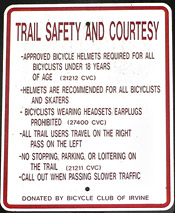Group Riding
There are cycling etiquette you should be aware of whenever cycling in a group.
Be Predictable; Group riding requires even more attention to predictability than riding alone. Other riders expect you to continue straight ahead at a constant speed unless you indicate differently. Motorists look for vehicles in the road; operating as a vehicle increases safety. Bicyclists are subject to the same rules of the road as motorists. Pass others on their left. Say "on your left" to warn others that you are passing. If you need to pass someone on the right, say "on you right" clearly since this is an unusual maneuver. If you need to take the lane, signal and communicate to the motorists too. It is safer to take the lane briefly rather than squeeze along on the edge or curb, inviting motorists to split a narrow lane with you.
Use Signals Use hand and verbal signals to communicate with others in the group and with motorists (directions and hazards).
Give Warnings to cyclists behind you of changes in direction or speed. The lead rider should call out "left" or "right," in addition to a hand signal. The lead rider should announce the turn well in advance of the intersection, so members of the group have time to position themselves properly for the turn. Most of the cyclists will not have a good view of the road surface ahead, so it is important to announce hazards. Indicate hazards by pointing down to the left or right and shouting, "hole left," "bump center," “rock right” etc. Everyone should be made aware of hazards, so every rider should call them out to the rider behind them...
Ride single or double file as appropriate to the roadway, traffic conditions and where allowed by law. Most state vehicle codes permit narrow vehicles such as bicycles and motorcycles to ride double file or ‘split’ a lane. Even where riding double is legal, courtesy dictates that you single up when cars are trying to pass you if the lane is wide enough for them to safely do so. The California motor vehicle law says “any person operating a bicycle upon a roadway at a speed less than the normal speed of traffic shall ride as close as practicable to the right hand curb or edge of the roadway, except: “when passing or making a left turn”. City of Irvine Municipal Code adds “or when reasonably necessary to avoid hazardous conditions that make it unsafe to continue along the right-hand curb or edge” Since some police officers see the California vehicle code as saying bicycles must stay as far to the right as practicable, riding side by side even, in a Class I on street bike lane, has been prosecuted as a violation of this law. The Irvine Municipal Code clarifies that IN IRVINE, “Persons riding bicycles upon a roadway or bike lane shall not ride more than two abreast.” The lead rider should call out "single up" or "double up," in addition to a hand signal.
Maintain Your Place In Line; When a group gets to a signal, do not take this as an opportunity to cut to the front of the others in the group; If you get there first, push the pedestrian button to help more of the group to get through a longer light. Clustering up at intersections clogs traffic and causes unnecessary chaos when the light turns green. Experienced riders line up and stay in order. If you are the 12th to get there, stay in order. Slower riders who cut into the front force everyone they cut in front of to pass them again and cause a bunch up at the limit line. Instead, maintain your position in the single or double line & work on your own pace when safely rolling along.
Watch Out At Intersections; When approaching intersections requiring you to yield or stop, the lead rider should say "slowing" or "stopping" to alert those behind them. When passing through an intersection, some bicyclists say, "clear" if there is no cross traffic. This is a dangerous practice. It encourages riders to let others do their thinking for them. Each bicyclist is responsible for his or her own safety.
Activate Signals; Most signals in Irvine will respond to one bicycle wheel over the loop detector in the pavement or with video detection. When a group gets to a signal, the first rider on the right may move over to corner to push the white pedestrian cross walk button. This button will hold the cross walk signal longer than the green bicycle button which may only allow a few bicyclists to cross.
Watch For Traffic Coming From The Rear; Even when you are occupying the proper lane position, it often helps to know when a car is overtaking. Since those in front cannot clearly see traffic approaching from the rear, it is the responsibility of the riders in back to inform the others by saying "car back” or “bike back”. It also helps move right to help faster riders pass on the left. Around curves, on narrow roads, or when riding double, it is also helpful to warn of traffic approaching from ahead with "car up."
Leave a Gap for Cars between every three or six bicycles when riding up hills or on narrow roads. This way a motorist can use shorter passing intervals and won’t have to race to move around the entire group.
Move Off the Road When You Stop, well off the road so you do not interfere with traffic. When you start again, each bicyclist should look for, and yield to, traffic.
Pass on Left – Lights/Reflectors at Night – Earphones not in both ears – Safe Speed (Basic Speed Law) are all in the CVC.
CLASS 1 OFF STREET Bike Path
and SHARED-use PATH Riding
‘Shared-use’ paved paths, often called “trails”, can become quite popular. As a result, shared-use paths have become more congested and safety is a major issue. A true Class I bike path provides a separate walkway for pedestrians. Shared-use paths in Orange County are posted 10 MPH speed limit, and pedestrians have the right of way, so expecting surprises & maintaining a safe speed is important. Paths have engineering and design limitations that require you to ride differently than you would on the road. If your preferred speed or style of cycling is inappropriate for paths, look for better-suited alternative street routes. Class 3 (28 mph) EBikes are prohibited from paths including Class I bikeways unless adjacent to a roadway. Even though a path is paved and a trail is not, the City and many users call shared-use paths “bike trails”. Actual dirt trails have other tips and restrictions, like eBikes are not allowed on most and many do not allow bicycles. We try to use path rather than trail when describing a paved path.
Bike Paths and Shared-Use Paths have engineering and design limitations that require you to ride differently than you would on the road. If your preferred speed or a style of cycling is inappropriate for paths, look for better-suited on-street routes or slow down and learn to safely share. Many Bike Paths in Orange County are posted 10 MPH and some are only open for public use between dawn & dusk.
Be Alert All users should remain alert to traffic; mirrors help see faster users coming from behind. Stereo headphones can eliminate important passing signals.
Be Predictable Ride straight ahead. Indicate when you are turning. Warn other users of your intentions.
Be Courteous All users, including bicyclists, joggers and wheelchair users, should be respectful of other users, regardless of their mode of travel, speed, or skill level.
Do Not Block the Path When riding in a group, keep to the right half of the path. On many heavy use or narrow paths, this means that all users will need to stay single file. If you stop to regroup, fix a flat, or bird watch, always do it off the path.
Keep Right You should stay as close to the right side of the path as is safe, except when passing another user. Many smarter pedestrians walk facing traffic. This allows direct eye contact and reduces the surprise of a cyclist passing on their left, and allows them to step to their left & clear the path. Others with traffic with their backs to passing traffic. Walkers should not walk right down the middle, but they do. Be prepared for both; a couple of walkers in the middle of the path may step to opposite sides... the left one stepping right & the right one stepping left; bumping into each other, and still in the middle of the path. Slow down.
Pass on Left Look ahead and behind to make sure the lane is clear before pulling out. Pass with ample separation. Do not move back to the right until safely passed. Fast moving users are responsible for yielding to slower moving users.
Give an Audible Signal Before Passing This signal may be a bell or your voice. Warn well in advance so that the slower user has time to react and you have time to maneuver if necessary. "Passing on your left" is the most common signal used to alert other users of your approach. “Good morning” also does the trick most of the time. Watch for headsets - they may not hear your warning so pass gently. Some even mention “there are 10 more right behind me” as they pass... “On Your Left” means “Hi - I am passing you” not “GET OUT’A MY WAY!”
Use Caution When Entering & Crossing Other Paths At intersections, slow down and be prepared to yield to traffic on the cross path or road. This is often the most dangerous point on a path.
Use Lights at Night If you are riding between dusk and dawn, California law requires you to have a light & reflectors on roads, sidewalks and paths. Bikes require a white front light and a red rear reflector. Wheel or tire and pedal/shoe or ankle reflectors are also required. Not required, but a red tail light is a good idea. High power lights can blind oncoming traffic, and are blinding to follow. Aim headlights at the path. Many tail lights are adjustable & can be dimmed. Lights should be on solid, not flashing at night. A second tail light blinking can help make you more visible. Extra reflective surfaces and lights can also help be seen.
Clean up Litter along the path. Carry it until you find a litter receptacle. Go the extra mile - pack out more trash than you bring in.
Equestrians Some paths – especially with adjacent trails - may have horses or other livestock. Horses can spook unpredictably, and if coming the other way, people should stop, allowing the horses to safely go by. If overtaking horses, follow for a time at a distance. The horses’ ears will swivel back when they hear you, and they will not be as surprised. The horse riders should let you know when it is safe to pass, or will pull off the path allowing extra room to pass. Slowly pedal past a horse; freewheel clicking can sound like a rattlesnake.
Sources: Most of these tips were copied from "Bicycle USA", the magazine of the League of American Bicyclists ( bikeleague.org )
The information has been slightly modified and expanded to educate riders with the Bicycle Club of Irvine
Learn more: here are some of the documents reviewed & handed out at NewB classes:
CVC Laws for Cyclists - 2020 update (pdf)
BCI Etiquette - Covers some basics of group and multi-use path cycling (pdf)
ABC Quick Check and the "10 Commandments" / 5 Rules of cycling (pdf)
Behavior Types: Discussion on Road using vs Edge cycling vs Sidewalk Cycling (pdf)
Pamphlet on Sidewalk Riding (pdf)
Pamphlet on Bike Path Riding (pdf)
”Share the Trail!” on shared-use paths - California update (png)
Here is an excellent on-line tutorial explaining Lane Position & why we don't edge ride the gutter, especially in narrow lanes: Understanding Cyclists Position on the Roadway
Here is a classic film from 1954: Drive your Bicycle









